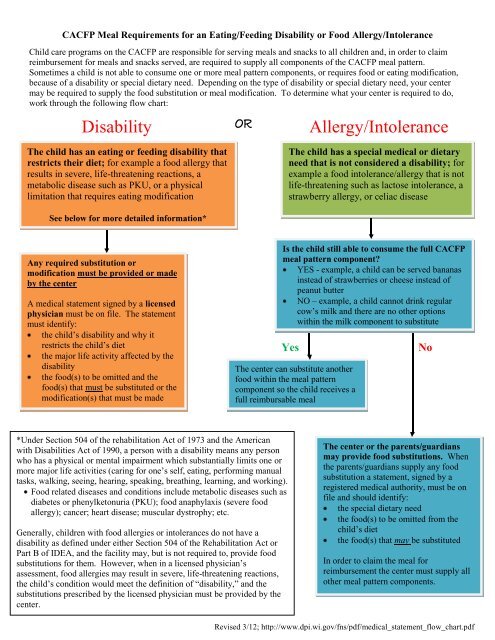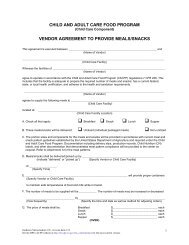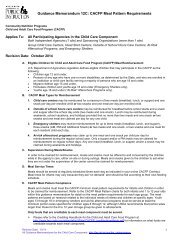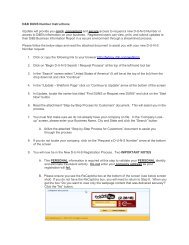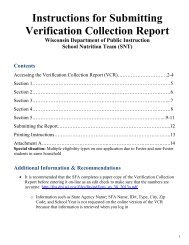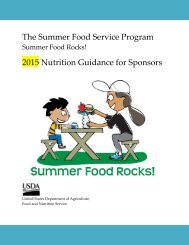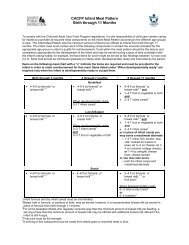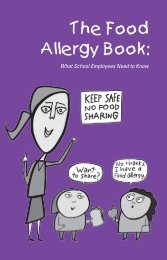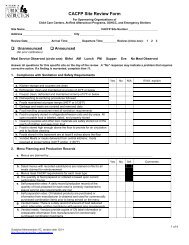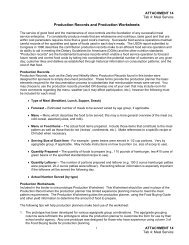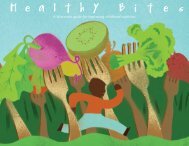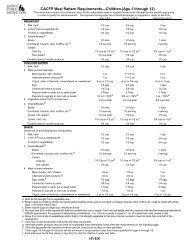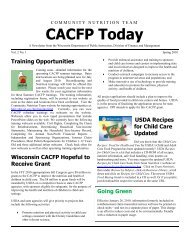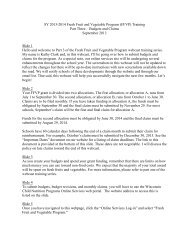Medical Statement Flow Chart - WI Child Nutrition Programs (FNS)
Medical Statement Flow Chart - WI Child Nutrition Programs (FNS)
Medical Statement Flow Chart - WI Child Nutrition Programs (FNS)
Create successful ePaper yourself
Turn your PDF publications into a flip-book with our unique Google optimized e-Paper software.
CACFP Meal Requirements for an Eating/Feeding Disability or Food Allergy/Intolerance<br />
<strong>Child</strong> care programs on the CACFP are responsible for serving meals and snacks to all children and, in order to claim<br />
reimbursement for meals and snacks served, are required to supply all components of the CACFP meal pattern.<br />
Sometimes a child is not able to consume one or more meal pattern components, or requires food or eating modification,<br />
because of a disability or special dietary need. Depending on the type of disability or special dietary need, your center<br />
may be required to supply the food substitution or meal modification. To determine what your center is required to do,<br />
work through the following flow chart:<br />
Disability<br />
OR<br />
Allergy/Intolerance<br />
The child has an eating or feeding disability that<br />
restricts their diet; for example a food allergy that<br />
results in severe, life-threatening reactions, a<br />
metabolic disease such as PKU, or a physical<br />
limitation that requires eating modification<br />
The child has a special medical or dietary<br />
need that is not considered a disability; for<br />
example a food intolerance/allergy that is not<br />
life-threatening such as lactose intolerance, a<br />
strawberry allergy, or celiac disease<br />
See below for more detailed information*<br />
Any required substitution or<br />
modification must be provided or made<br />
by the center<br />
A medical statement signed by a licensed<br />
physician must be on file. The statement<br />
must identify:<br />
the child’s disability and why it<br />
restricts the child’s diet<br />
the major life activity affected by the<br />
disability<br />
the food(s) to be omitted and the<br />
food(s) that must be substituted or the<br />
modification(s) that must be made<br />
Is the child still able to consume the full CACFP<br />
meal pattern component?<br />
YES - example, a child can be served bananas<br />
instead of strawberries or cheese instead of<br />
peanut butter<br />
NO – example, a child cannot drink regular<br />
cow’s milk and there are no other options<br />
within the milk component to substitute<br />
Yes<br />
The center can substitute another<br />
food within the meal pattern<br />
component so the child receives a<br />
full reimbursable meal<br />
No<br />
*Under Section 504 of the rehabilitation Act of 1973 and the American<br />
with Disabilities Act of 1990, a person with a disability means any person<br />
who has a physical or mental impairment which substantially limits one or<br />
more major life activities (caring for one’s self, eating, performing manual<br />
tasks, walking, seeing, hearing, speaking, breathing, learning, and working).<br />
Food related diseases and conditions include metabolic diseases such as<br />
diabetes or phenylketonuria (PKU); food anaphylaxis (severe food<br />
allergy); cancer; heart disease; muscular dystrophy; etc.<br />
Generally, children with food allergies or intolerances do not have a<br />
disability as defined under either Section 504 of the Rehabilitation Act or<br />
Part B of IDEA, and the facility may, but is not required to, provide food<br />
substitutions for them. However, when in a licensed physician’s<br />
assessment, food allergies may result in severe, life-threatening reactions,<br />
the child’s condition would meet the definition of “disability,” and the<br />
substitutions prescribed by the licensed physician must be provided by the<br />
center.<br />
The center or the parents/guardians<br />
may provide food substitutions. When<br />
the parents/guardians supply any food<br />
substitution a statement, signed by a<br />
registered medical authority, must be on<br />
file and should identify:<br />
the special dietary need<br />
the food(s) to be omitted from the<br />
child’s diet<br />
the food(s) that may be substituted<br />
In order to claim the meal for<br />
reimbursement the center must supply all<br />
other meal pattern components.<br />
Revised 3/12; http://www.dpi.wi.gov/fns/pdf/medical_statement_flow_chart.pdf
CACFP Meal Requirements for Lifestyle Choices<br />
Special dietary practices such as eating vegetarian, organic or eliminating certain foods for religious reasons are not exempt from the CACFP meal<br />
pattern meaning the full meal pattern must be supplied by the center in order to claim the meal for reimbursement. If a meal component is eliminated<br />
because of dietary practices, or if the parent/guardian supplies any component of the meal, the center cannot claim the meal for reimbursement. The<br />
only exception to this is with serving a non-dairy milk substitute.<br />
Is there a medical reason for the parent/guardian wanting their child to drink something other than regular cow’s milk?<br />
Is there a medical statement from a medical authority on file including:<br />
the reason for the milk substitution<br />
a statement that milk is to be omitted from the child’s diet<br />
the type of non-dairy milk or other beverage that may be substituted<br />
YES<br />
Does the<br />
parent/guardian<br />
or center supply<br />
the substitute?<br />
Yes<br />
Yes<br />
NO<br />
Does the center supply a creditable<br />
dairy milk substitute (e.g. low-fat or fatfree<br />
lactose-free, lactose-reduced,<br />
buttermilk or acidified milk)?<br />
No<br />
Does the parent/guardian supply a<br />
non-dairy milk substitute?<br />
No<br />
The parent/guardian may request in writing that their child be<br />
served a non-dairy milk substitution. The request should include:<br />
the reason for the non-dairy milk substitution (i.e. life style choice)<br />
the specific type of non-dairy beverage to be substituted<br />
o the substitution must be nutritionally equivalent to milk and<br />
meet all of the nutritional standards for fortification of<br />
calcium, protein, vitamins A and D and other nutrients to levels<br />
found in cow’s milk listed below:<br />
Milk Substitute <strong>Nutrition</strong> Standards<br />
Nutrient Per Cup<br />
Calcium<br />
276 mg<br />
Protein<br />
8 g<br />
Vitamin A 500 IU<br />
Vitamin D 100 IU<br />
Magnesium 24 mg<br />
Phosphorus 222 mg<br />
Potassium 349 mg<br />
Riboflavin .44 mg<br />
Vitamin B-12 1.1mcg (μg)<br />
See list of approved non-dairy beverages in GM #12C<br />
Center can<br />
claim the<br />
meal(s) for<br />
reimbursement<br />
Yes<br />
No<br />
Center cannot claim<br />
the meal(s) for<br />
reimbursement<br />
Yes<br />
Center can claim<br />
the meal(s) for<br />
reimbursement<br />
Yes<br />
Does the parent /guardian or center supply one<br />
of the approved substitutes?<br />
No<br />
Does the parent/guardian or<br />
center supply an<br />
unapproved substitute?<br />
Center cannot<br />
claim the<br />
meal(s) for<br />
reimbursement


